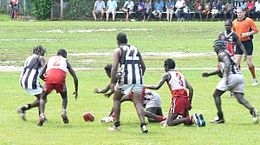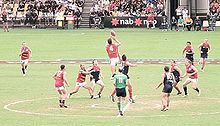- Australian rules football in Australia
-
Australian rules football in Australia 
Contesting for possession in an indigenous community football game in the Northern Territory Governing body Australian Football League National team Australia First played 1858, Melbourne, Victoria Registered players 615,549 (total)[1]
120,000 (adult)Clubs 2,548[citation needed] Competitions National Australian Football League Club Foxtel Cup North East Australian Football League Northern Territory Football League Ovens & Murray Football League South Australian National Football League Tasmanian State League Victorian Football League West Australian Football League Audience records Single match 121,696 - Collingwood vs Carlton, at the MCG (1970 VFL Grand Final) Season 7,083,015 - 2008 AFL season Australian rules football originated in Melbourne in 1858. It has continuously in every state and territory[2] of Australia since 1915 and is particularly popular in Victoria, South Australia, Western Australia and Tasmania, where it is the most watched sport, and Northern Territory where it is the most played sport. The Barassi Line has been used in reference to the contrasting lack of popularity of the sport in the populous states of Queensland and New South Wales. However in recent years the sport's popularity has grown nationally and it has grown in importance to Australian culture as a whole.
The only national professional competition is the Australian Football League, which grew out out of the former Victorian Football League (not to be confused with the present-day Victorian Football League, changing its name in 1990 after expanding into other states. The AFL now governs the code nationally. Australia is currently the only nation in the world where Australian rules football is played professionally.
Contents
Australian rules football in Australian popular culture
Main article: Australian rules football in popular Australian cultureAudience
Attendance
Football is the most highly attended spectator sport in Australia. Government figures show that more than 2.5 million people (16.8% of the population) attended games in 1999.[3] In 2005, a cumulative 6,283,788 people attended Australian Football League (AFL) premiership matches, a record for the competition.[4] A further 307,181 attended NAB Cup pre-season matches and 117,552 attended Regional Challenge pre-season practice matches around the country.[5]
As well as the AFL attendances, strong state competitions also drew crowds. Although crowds for local leagues have droppedin recent years, they continue to draw support, particularly for finals matches. The South Australian SANFL drew an attendance of 303,354 in 2005, the Western Australian WAFL drew an official attendance of 202,797 in 2004.
As of 2010, the AFL is one of only five professional sports leagues with an average attendance of over 30,000 per game, ranking 3rd behind the NFL and the Bundesliga
Television
According to OzTAM, in recent years, the AFL Grand Final has reached the top five programs across the five biggest cities in 2002, 2003, 2004, 2005 and 2006. Australian rules football has achieved a #1 rating in the sports category in both 2004 and 2005.
Participation
A total of 615,549 registered participants are playing Australian football in 2007, placing it ahead of cricket (471,329 total participants) and soccer (389,000 total participants). Participation rose 5.97% between 2006–07 and 7.84% between 2005-06. 6.7 per cent of all participants are from non-English speaking origin. The Australian Sports Commission statistics show a 42% increase in the total number of participants over the 4 year period between 2001-2005.[6]
Amongst children aged 5 to 14 years, football is the third most popular organised sport for children to participate in (beyond soccer and swimming). An estimated 284,200 children aged 5 to 14 participated in football in the 12 months prior to interview in 2003 (13.6% of all children).[7]Australian and cultural issues
Main article: Australian rules football cultureDrug abuse
Performance enhancing drug abuse is also rare according to official studies[8] despite some high profile recent cases[who?] and criticisms from the media and government[9] of the AFL's own anti-doping code[10] which allows players to test positive twice to recreational drugs and still continue to play and remain anonymous. This relaxed approach does not comply with the World Anti-Doping Agency protocols.
Racism
Further information: Racism in sportDespite the sport's high multicultural participation, racism has been and continues to be an issue in Australian football at all levels. The governing body, the AFL introduced racial vilification rules in 1995 at all levels and is now considered a world leader in the field.[11]
Structure and competitions
 An Australian Football League match at Carrara Stadium on the Gold Coast. Adelaide's Matthew Clarke and Melbourne's Mark Jamar contest a centre bounce. The man in the green shirt is a central field umpire.
An Australian Football League match at Carrara Stadium on the Gold Coast. Adelaide's Matthew Clarke and Melbourne's Mark Jamar contest a centre bounce. The man in the green shirt is a central field umpire.
The most powerful organisation and competition within the game is the elite professional Australian Football League (AFL). The AFL is recognised by the Australian Sports Commission as being the National Sporting Organisation for Australian rules football. There are also seven state/territory-based organisations in Australia, most of which are affiliated to the AFL. Most of these hold annual semi-professional club competitions while the others oversee more than one league. Local semi-professional or amateur organizations and competitions are affiliated to their state leagues.
National Championships
Senior
Further information: Interstate matches in Australian rules footballThe last senior national carnival was held in 1988 and the last match between interstate senior sides was held in 1999. Senior interstate competition is no longer contested by players from the Australian Football League. A one-off exhibition match featuring Victoria and a "Dream Team". However, the state leagues continue to compete in inter-league matches.
Under 18
Main article: AFL National Under 18 ChampionshipsThe AFL National Under 18 Championships are the annual national Australian rules football championships for players aged 18 years or younger and includes teams from each Australian state or Territory. The competition is monitored by AFL recruiters and frequently seen as the second biggest pathway for junior players to the fully professional Australian Football League. The competition is currently sponsored by the National Australia Bank. The competition receives an increasing amount of coverage in the media, however still lags behind the TAC Cup in terms of interest in Victoria.
References
- ^ More chase Sherrin than before
- ^ excluding Jervis Bay and external territories
- ^ Sports Attendance, Australian Bureau of Statistics, April 1999.
- ^ "Aussie Rules sets attendance record". The Sydney Morning Herald. 2005-08-28. http://www.smh.com.au/news/Sport/Aussie-Rules-sets-attendance-record/2005/08/28/1125167544791.html.
- ^ 403 Forbidden
- ^ Participation in Exercise, Recreation and Sport Survey 2005 Annual Report
- ^ 4901.0 Children's Participation in Cultural and Leisure Activities, Australia (April 2003)
- ^ Drug doping in senior Australian rules football: a survey for frequency
- ^ AFL bows to federal anti-dope pressure
- ^ AFL Anti-Doping Code
- ^ http://www.theage.com.au/news/cricket/icc-may-adopt-afl-racial-vilification-laws/2008/07/09/1215282926817.html
See also
- Australian Football League
- Australian Institute of Sport
- List of Australian rules football clubs in Australia
Australian rules football in Australia National governing bodies By State or Territory Australian Capital Territory · New South Wales · Northern Territory · Queensland · South Australia · Tasmania · Victoria · Western Australia (Goldfields)Countries playing Australian rules football Oceania Australia · Fiji · Nauru · New Zealand · Papua New Guinea · Samoa · Solomon Islands · Tonga
Asia & Middle East Europe Africa Americas Argentina · Bermuda · Canada · Chile · United States
Sport in Australia By state/territory Major sports Athletics · Australian rules football · Baseball · Basketball · Cricket · Golf · Hockey · Horse racing (Thoroughbred, Harness, and Steeplechase) · Motorcycle sport · Motorsport · Netball · Rugby league · Rugby union · Swimming · Tennis · Soccer · Winter sports (skeleton, skiing) · Women's sportsMinor sports American football · Campdrafting · Futsal · Gaelic Games (Gaelic football, hurling) · Lacrosse · Polocrosse · Sheepdog trials · SoftballInternational sporting competitions Baseball World Cup, Commonwealth Games, FIFA Confederations Cup, FIFA World Cup, Olympics (Summer, Winter), Paralympics (Summer, Winter), Rugby World Cup, Cricket World CupCategories:- Australian rules football in Australia
- Sport in Australia by sport
Wikimedia Foundation. 2010.
